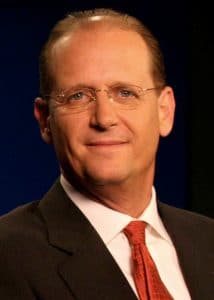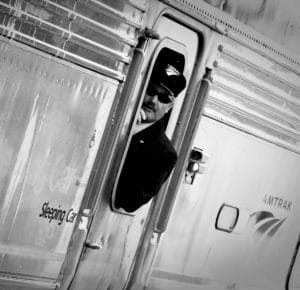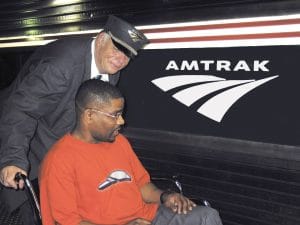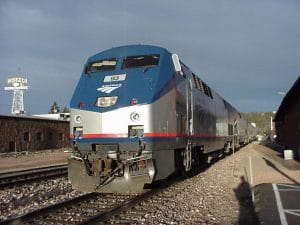A U.S. senator from Kansas received an assurance in a letter from Amtrak’s president and CEO that the national passenger carrier will maintain long-distance service at its current status quo through the 2019 fiscal year, which ends Sept. 30, and possibly on through the enactment period of the Fixing America’s Surface Transportation (FAST) Act, which runs through the 2020 fiscal year.
However, U.S. Sen. Jerry Moran’s delay on the consideration by the U.S. Senate of three presidential nominees to the Amtrak Board of Directors, which he started in early May, appears that it will continue.
Kansas News Service (ksnewsservice.org) reported that a spokesperson for the senator said a May 22 in-person meeting between Moran and Anderson was a “step in the right direction.” However, the holds Moran placed on President Donald Trump’s nominations to the Amtrak Board of Directors will remain while he awaits more answers to questions that arose from that meeting, the report said.
Moran is particularly concerned about the long-term future of the daily Chicago-to-Los Angeles Southwest Chief route. Last year, U.S. senators had to pressure the carrier to continue the route, which serves many rural areas, through the 2019 fiscal year.
Amtrak’s top boss, Richard Anderson, wrote in a letter to Moran that congressional action has secured the short-term future of the long-distance routes.
“We believe that Congress generally endorsed continued operation of our current route network for the five-year period from FY15-FY20 through the enactment of the Fixing America’s Surface Transportation (FAST) Act,” Anderson wrote. “Thus, although Amtrak is not technically required to operate any given route under the FAST Act, we plan on operating all of our long-distance trains for the remainder of this period while seeking to drive improved performance consistent with our goal to grow ridership while reducing Federal subsidies.”
However, Anderson also indicated that alterations to the long-distance interstate service again will be considered as the carrier seeks to build upon its recent performance, with increased ridership and record-setting fiscal performance with higher revenue and reduced operating losses.
“… We must position ourselves to attract a new generation of customers. Just as other modes of transportation and businesses are compelled to evolve, so must we if our mode is to grow as a relevant and efficient means of mass transportation,” Anderson wrote. “We owe this to our customers and your constituents, along with our nearly 20,000 hard-working and dedicated employees. That is why we have a plan to break even on operating results by 2020.”
Anderson went into detail about the financial performance and cost of the carrier’s long-distance routes and said more than half of the federal appropriations that Amtrak received went toward funding those routes.
“Long-distance trains require large federal subsidies because their revenues are lower and operating costs are higher than Amtrak’s state-supported and NEC (Northeast Corridor) services. The federal government is virtually the only funding source for the capital investments they require,” Anderson wrote. “These costs are set to increase significantly in the future as we face host railroad-related poor on-time performance across the network and much of our equipment used in long distance service reaches the end of its useful life and requires replacement.”
Discussion of an upcoming funding reauthorization in Congress will give a clearer indication of the future of the long-distance routes, Anderson said.
“Looking forward, we aim to have a conversation with Congress and our other stakeholders about the future of the long-distance services,” Anderson wrote. “While we strongly believe that there is a permanent place for high quality long-distance trains in our network, the time to closely examine the size and nature of that role is upon us for numerous reasons.”
The replacement of long-distance routes with new corridor service is certainly on the table for Amtrak, Anderson said. Among potential corridors warranting further study are Mobile, Alabama to New Orleans; Fort Worth, Texas to Newton, Kansas; Minneapolis and St. Paul, Minnesota to Chicago and Duluth, and the Front Range Corridor.
An initial analysis of these potential corridor routes is expected to be performed this summer, he wrote.
“Demand for shorter rail trips in corridors between major cities is increasing, particularly in the fast-growing South, Southwest and Mountain states,” Anderson wrote. “However, the minimal service Amtrak currently provides in these regions, with long-distance trains that are often many hours late and serve major cities in the middle of the night, does not meet the needs of their rapidly increasing populations.”
Follow this link to read Anderson’s full letter to the senator.
The three nominees whose nominations have been placed on hold by Moran are Rick Dearborn, Joseph Gruters and former U.S. Rep. Lynn Westmoreland. SMART TD opposes Westmoreland’s nomination.
Tag: Southwest Chief
Amtrak has informed federal, state and local officials along the route of the daily Chicago-to-Los Angeles Southwest Chief that it will provide matching funds to enable a federal grant to be awarded for safety and reliability upgrades in Kansas, Colorado and New Mexico, the carrier said in a news release Feb. 27.
The funds available to upgrade the route came after Congress passed and President Donald Trump signed the FY2019 Appropriations Act, which included funding for Amtrak and intercity passenger rail, earlier in the month.
The legislation set aside at least $50 million of its National Network grant for improvements to the Southwest Chief route. Amtrak is using $3 million of these funds to match a $16 million grant successfully sought by these states, counties and cities and awarded to Colfax County, N.M. The grant and matching funds from the partners will result in an investment of more than $26 million in preserving the daily route from Chicago to Los Angeles.
Amtrak and BNSF Railway began community discussions regarding safety and other infrastructure improvements in 2011. Since then, more than $80 million has been committed from U.S. Department of Transportation grant programs, state and local governments, Amtrak and BNSF.
As reported in prior articles published on the SMART Transportation Division website and in the SMART TD News, Amtrak has been considering “bus bridges” on portions of the route or the potential discontinuation of the route altogether.
“We’re glad it’s getting funds to go through Colorado,” said Colorado State Legislative Director Carl Smith. “We’re supportive of all measures to continuing the Chief’s service through our state.”
Amtrak said in the release that it will use the newly available federal capital funding to continue needed work on the next route segment in New Mexico.
The carrier said in its release it is working on a long-term financial plan with state and local partners to address the unique challenges of the Southwest Chief route, particularly where Amtrak is the only user of BNSF tracks in Colorado and New Mexico.

This amendment would provide resources for maintenance and safety improvements along the Southwest Chief route and would compel Amtrak to fulfill its promise of matching funding for the successful TIGER IX discretionary grant supported by the Kansas Department of Transportation and local communities along the route. In addition, this amendment would effectively reverse Amtrak’s decision to substitute rail service with bus service over large segments of the route through FY2019.
“As the divide between urban and rural communities in America continues to expand, passenger rail services like the Southwest Chief are invaluable in connecting Kansans to the rest of the country while also bringing visitors from out of state to our local communities,” said Sen. Moran. “I applaud the bipartisan efforts to keep the Southwest Chief operational for our rural communities and will continue working with Amtrak to make certain this route remains available for the Kansans who need it.”
“For the second time in two weeks, the Senate is speaking out with strong, bipartisan support for long-distance rail, especially the Southwest Chief — and this time with $50 million in new funding,” said Sen. Udall. “Replacing rail service with bus service between Dodge City, Kansas and Albuquerque, New Mexico would not only have completely disrupted service for Amtrak passengers, it would have discouraged riders from taking the Southwest Chief in the first place, adding to Amtrak’s financial problems. The Southwest Chief route is an economic engine in New Mexico, giving passengers a ride through time — through the historic West — and connecting our communities. The additional funding from our amendment will make sure the Southwest Chief gets back on a sound financial track. I remain committed to working with our communities, Amtrak leadership, and other stakeholders to keep the Chief running long into the future.”
“I am pleased the Senate has approved our amendment to ensure continuous rail service on all long distance routes, especially the Southwest Chief,” said Sen. Roberts. “We heard from many Kansans strongly opposed to the proposed bus service within the route.”
“I’m excited to support an amendment that will greatly help the Southwest Chief’s continued presence in southeastern Colorado,” said Sen. Gardner. “The amendment secured by the bipartisan coalition in the appropriations bill will set aside funding for route improvements and enhancements, providing the opportunity to ensure the Southwest Chief stays in Colorado and continues servicing the rural areas that desperately need it.”
“The Southwest Chief is an important component of Southeastern Colorado’s tourism economy, and we will do all we can to preserve it,” said Sen. Bennet. “We’ll continue to work closely with lawmakers from Colorado—and also New Mexico and Kansas—to keep running the Southwest Chief through our state.”
“I’m proud to help lead this bipartisan coalition in the Senate to save the Southwest Chief, and I hope that my colleagues in the House of Representatives agree that fighting for infrastructure in rural America is good for our economy as a whole,” said Sen. Heinrich. “Each year, the Southwest Chief brings thousands of Boy Scouts from around the country to New Mexico’s Philmont Boy Scout Ranch and generates economic activity in our communities like Raton, Las Vegas, and Lamy. It makes no sense for Amtrak to provide inferior service while cutting out a key part of rural America. We’re going to continue fighting any effort to undermine this important route.”
The Southwest Chief runs daily between Chicago and Los Angeles and connects towns and cities in Kansas, Illinois, Missouri, Iowa, Colorado, New Mexico, Arizona and California and provides passenger train and long-distance passenger service, particularly through rural communities. The Southwest Chief stops in several Kansas communities including Lawrence, Topeka, Newton, Hutchinson, Dodge City and Garden City.
Items to Note:
- Last week, the Senate overwhelmingly passed a Sense of the Congress measure to affirm support for the long-distance rail service.
- Last month, the senators sent a letter to Amtrak’s CEO urging him to uphold Amtrak’s side of a longstanding public-private partnership to continue operating the Southwest Chief passenger train and long-distance passenger service.
- In May, the senators sent a bipartisan, multi-state letter condemning Amtrak’s decision not to match TIGER grant funds.
The above press release was released by Sen. Jerry Moran (R – Kan.) on Aug. 1, 2018, and originally appeared here.
The public and members of Congress have been vocal in their displeasure with Amtrak’s announcements of cuts and planned cuts to service, including replacement of dining car service with boxed lunches on some routes, de-staffing 15 train stations around the country that serve less than 40 passengers per day and a proposal to substitute parts of the Southwest Chief train route with bus service.
Hot meals a thing of the past on select routes

Julie King, executive director of the National Railroad Hall of Fame and the American Association of Private Railroad Car Owners, has expressed concern that the changes will dissuade customers from riding on trains.
“When you’re on a very long train trip, the equivalent of a boxed lunch is not going to enhance your experience,” King said. “The lack of train attendants has the same impact. It makes it difficult for people to get their questions answered and get tickets.”
De-staffing stations

The staff cuts also have gotten the attention of senators. Ohio Sens. Rob Portman (R) and Sherrod Brown (D) have introduced an amendment to H.R. 6147, the 2019 fiscal transportation legislation, as a result of the de-staffing. If passed, the amendment would require Amtrak to staff any station that has averaged at least 25 passengers per day in the last five years.
“The services Amtrak staff provide are important to all passengers … but this is particularly true for elderly and disabled individuals who may have to carry baggage down to the train platform unassisted, often late at night,” Portman said.
Southwest Chief: train to bus service?

“The proposal would leave a 500-mile gap in the rail network, it would displace thousands of riders from the train and is projected to lose as much as 70 percent of current revenue generated,” the RPA said.
The RPA has started a petition on its website, www.railpassengers.org, in the hopes that Amtrak will reconsider its proposals.
SMART TD Colorado State Legislative Director Carl Smith said he is dismayed at the potential loss of jobs and the hardships that current passengers will face if Amtrak has its way.
“The Southwest Chief is critical infrastructure to sustaining good jobs in rural areas as well as providing passenger transportation to under-served areas that do not have ready access to other forms of travel to larger metropolitan areas,” Smith said.
The Texas Eagle Marketing and Performance Organization (TEMPO), which was created in the 1990s when Amtrak was looking to discontinue service on the Texas Eagle, a line that stops in Chicago; San Antonio; Fort Worth, Texas; and Los Angeles, has also been outspoken about the changes Amtrak is proposing.
“Over the years we’ve had to battle with Congress to fund these trains, but now it seems the battle is with Amtrak itself,” said TEMPO’s Dr. William Pollard after hearing about Amtrak’s planned cuts.
Members of Congress expressed their concern after Amtrak’s CEO Richard Anderson announced that he plans to renege on deals with affected states Amtrak had made under then-CEO Joe Boardman to keep the Southwest Chief running.
In a bipartisan letter to Amtrak’s Anderson, U.S. Sens. Marin Heinrich (D – N.M.), Tom Udall (D – N.M.), Michael Bennet (D – Colo.), Richard Durbin (D – Ill.), Tammy Duckworth (D – Ill), Dianne Feinstein (D – Calif.), Kamala Harris (D – Calif.), Pat Roberts (R – Kan.), Jerry Moran (R – Kan.) and Cory Gardner (R – Colo.) wrote: “The potential suspension of rail service has raised serious concerns among our constituents who depend on the Southwest Chief. We strongly disagree with such a decision and urge you to uphold Amtrak’s commitment to intercity rail service across the entire national network, particularly through our rural communities.”
The Senate has since passed an amendment to the chamber’s fiscal 2019 transportation legislation to force Amtrak to keep running its long-distance routes. Amendment No. 3414 of the funding bill H.R. 6147 says, “It is the sense of Congress that 1) long distance routes provide much needed transportation access to millions of riders in 325 communities in 40 states, and are particularly important in rural areas; and 2) long distance passenger rail routes and services should be sustained to ensure connectivity throughout the national network.”
That amendment passed, 95 to 4. The clear objective of the amendment is to tell Amtrak that it cannot be the sole decision-maker in the decision to scrap portions of the national network.
“Now, more than ever, we need a ‘national’ rail system. It’s sad that we need the representatives and senators of the people to mandate the CEO of Amtrak to continue to operate a national system instead of dismantling it,” said Dirk Sampson, general chairperson of Amtrak GO 769.

Read the complete article here.

Funding to save the Southwest Chief did not make it into the budget proposed by the Colorado legislature this week, Colorado State Legislative Director Carl Smith reports.
“We must now seek support from Gov. Hickenlooper and the Joint Budget Committee, which will review appropriation requests beyond the current proposed budget,” Smith said. “We need to get their attention and approval as soon as possible. Please call the governor and the following legislators and ask them to fund the Southwest Chief Commission.
“This train is essential to Colorado’s transportation system,” Smith said. “You might also remind Gov. Hickenlooper that he committed to finding funding for the train at the bill signing last year.”
Hickenlooper’s office phone number is (303) 866-2471.
For funding to pass, the bill needs the support of the following members from the state’s Joint Budget Committee:
- Sen. Kevin Grantham, (303) 866-4877, Kevin.Gratham.senate@state.co.us
- Sen. Pat Steadman, (303) 866-4861, Pat.Steadman.senate@state.co.us
- Rep. Millie Hamner, (303) 866-2952, Millie.Hamner.house@state.co.us
- Rep. Dave Young, (303) 866 2929, Dave.Young.house@state.co.us

Colorado State Legislative Director Carl Smith asks that all members from the state call or email key legislators to pass the bill funding Amtrak’s Southwest Chief.
“A bill to save the Southwest Chief will be heading to the Colorado Legislature’s Senate Appropriations Committee very soon. We need you to contact key legislators today to help save Amtrak service in Colorado,” Smith said.
“As you may know, SMART Transportation Division and our partners have been working over the past several years to save passenger rail in Kansas, Colorado and New Mexico. After a lot of hard work, we now have a bill that gets the fight to preserve Amtrak’s Southwest Chief over the line in Colorado. State Sens. Leroy Garcia (D-Pueblo) and Larry Crowder (R-Alamosa) have introduced Senate Bill 176, a bill that will fund the remaining portion of Colorado’s share of capital costs to save Amtrak for Colorado’s passengers. The bill was endorsed by the Transportation Committee last month, but now it needs to pass the Senate Appropriations Committee before it can reach the full State Senate.
“Your voice will make the difference! Following negotiations, advocates for rail service have managed to cut Colorado’s total share of costs to rehabilitate the Southwest Chief’s tracks from $40 million to $8.9 million. This is a huge victory for passengers, and it only happened because of the federal grant that Southeastern Colorado communities successfully applied for in 2014 in collaboration with Kansas, Amtrak, and BNSF Railway.
“Please take a moment today and contact the following senators via email and phone (it’s fine to leave a message):
- Sen. Kevin Grantham: (303) 866-4877, kevin.grantham.senate@state.co.us
- Sen. Mary Hodge: (303) 866-4855, mary.hodge.senate@state.co.us
- Sen. Rollie Heath, (303) 866-4872, rollie.heath.senate@state.co.us
What we need you to say:
“Personalize your message, but make sure to clearly ask for their support of SB-176 in the Senate Appropriations Committee. And remember: always be respectful.
“Here are a few other points that you can make to the senators about why the Southwest Chief is so important to the people of Colorado:
- The cost has gone done almost 80 percent because of successful negotiations between the state and other stakeholders;
- No less than 12 local communities in Southeastern Colorado have already stepped up and paid their share to keep the train running;
- We need to support rural Colorado;
- Amtrak, BNSF Railway, and the state of Kansas have already spent millions on this project-it’s Colorado’s turn to show our support.”

The bill has the support of the Transportation Division’s Colorado State Legislative Board, Legislative Director Carl Smith reports.
Smith said that SMART members will be at the state capitol March 2 to ask legislators to support the measure and other important labor legislation affecting working families in Colorado. He encourages all SMART members to participate. They will meet in the basement cafe of the capitol, located at 200 E. Colfax in Denver, at 9 a.m. Lunch will be provided by the state legislative board.
“The Southwest Chief is a lifeline for southern Colorado’s economy and I’m looking forward to possibilities of expanding service in the future,” said Sen. Leroy Garcia (D-Pueblo), co-prime sponsor of the bill. “I was pleased to see bipartisan support for this important rail line; it will be good for tourism and provide needed help to our rural economies in this region of Colorado.”
Sen. Garcia was a member of the House of Representatives from 2013 to 2014 and was the prime House sponsor of a bill – H.B. 14-1161 – establishing the Southwest Chief Rail Line Commission. The commission was tasked with ensuring rail line service would continue in Colorado.
The bill as written would appropriate $8.91 million in state General Fund money to the commission’s fund and modify some of the commission’s expenditure requirements from last year’s bill. Under this year’s bill, Amtrak would be required to explore the economic benefits of adding a stop in Pueblo to the services this vital line provides to Southeastern Colorado. Amtrak is already expected to explore the benefits of adding regular stops in Walsenburg.
Supporters of the bill include Pueblo County, ColoRail Association and Amtrak.
The bill will now move to the Senate Appropriations Committee for its next hearing.

The current Amtrak passenger service in southern Colorado is funded by the federal government under the Rail Passenger Service Act, which gives Amtrak the right to run passenger rail train over freight routes. Due to Amtrak funding cuts by Congress, Amtrak is unable to fully pay for track maintenance on the long distance passenger routes like the Southwest Chief. Without an alternate source of funding for maintenance, this vital passenger service could be discontinued on Jan. 1, 2015.
“H.B. 1161 is not a jobs bill, but a careers bill for southern Colorado. SMART Union members don’t have jobs on the railroad, they have long term careers on the railroad in rural communities of Southern Colorado,” said Carl Smith, SMART Transportation Division Colorado Legislative Director. “We are very proud to have the governor on board with such an important bill.
State Sen. Larry Crowder (R-Alamosa) and state Rep. Leroy Garcia (D-Pueblo) were prime sponsors of the bill.
The estimated cost of maintaining the line is $200 million. There is a proposal of a possibly five-way split between the states of Colorado, Kansas, New Mexico, Amtrak and BNSF Railway to pay for the upkeep, requiring $4 million a year for 10 years from each party. There are no state funds committed unless all the parties are on board.

But soon the picturesque views of the Sangre de Cristo Mountains that passengers have enjoyed could be replaced by the flat plains of Oklahoma and Texas. Amtrak is considering a plan to reroute the historic train from Colorado in two years to better-maintained tracks.
Maintenance to the more than 600 miles of current train rails between Hutchinson, Kan., and Albuquerque is estimated at about $200 million. Amtrak has said it will pay $40 million to repair the current route. Burlington Northern Santa Fe Railway, which owns the tracks and operates freight trains, has not made a commitment.
Read more at The Denver Post.